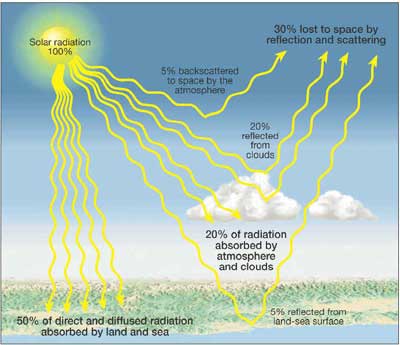Incoming heat being absorbed by the Earth, and outgoing heat escaping the Earth in the form of radiation are both perfectly balanced. If they were not balanced, then Earth would be getting either progressively warmer or progressively cooler with each passing year. This balance between incoming and outgoing heat is known as Earth’s heat budget.
While on average, Earth’s heat budget is balanced, the interactions that take place as heat and electromagnetic radiation interact with Earth and its many objects, oceans, and atmosphere are complex. Over all they balance out, however, some places are hotter or cooler day in and day out.
Let’s consider how heat is absorbed and passed around throughout the many different parts of our planet. Remember that almost all of the heat on Earth was originally created by the Sun. This electromagnetic energy travels towards the Earth at light speed in the form of ultraviolet radiation, visible light, and infrared radiation. When this energy reaches the Earth, immediately 30% of it bounces off, being reflected back out into space. The ability to reflect the light and radiation of the Sun is known as an object’s albedo. Because the Earth reflects 30% of the light that hits it, it is said that the Earth has an albedo of 30. In contrast, our moon has an albedo of 11. This means that if you were standing on the Moon looking up at the Earth, our planet would appear almost 3 times brighter than looking at the Moon from Earth.
Because 30% of the electromagnetic energy from the Sun has been reflected away, only 70% remains to interact with the Earth and warm it up. 20% of the energy from the Sun is absorbed by the atmosphere as a whole heating it up. This leaves 50% of the Sun’s energy to heat both the surface of the Earth as well as the oceans, lakes and streams.






